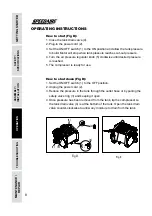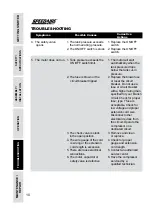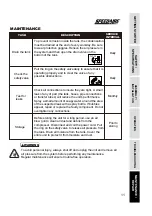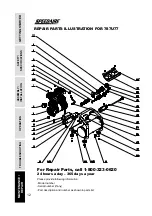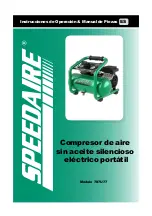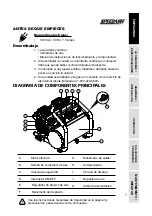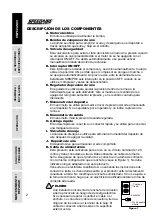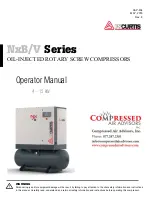
9
TROUBLESHOOTING
Possible Causes
Symptoms
Corrective
Actions
1. There is low pressure,
not enough air, or the
compressor does
not stop.
2. Air leaks from the
regulator or the
regulator does not
regulate air pressure.
1. The tank drain valve is open.
2. There is a leak in the fittings.
3. There is a prolonged or
excessive use of air.
4. The CFM of this unit is
not large enough.
5. There is a hole in the
air hose.
6. The tank leaks.
7. The seals are blown.
8. The valve leaks.
9. There is a leaking or
worn piston.
1. The internal parts of the
regulator are dirty or
damaged.
1. Replace the regulator or
internal parts.
3. The outlet pressure
gauge reading drops
when the air accessory
is being used.
1. This is normal.
2. The CFM of this unit is
not large enough.
1. If the pressure drops
too low, adjust the outlet
pressure gauge while
the accessory is used.
2. Check the air requirement
of the accessory. If it is
higher than the CFM and
the pressure supplied by
the compressor, you need
a larger compressor. Most
accessories are rated at
25% of the actual CFM
while running continuously.
1. Close the drain valve.
2. Check fittings with soapy
water. Tighten or reseal
leaking fittings. DO NOT
OVERTIGHTEN.
3. Decrease the amount of
air used.
4. Check the air requirement
of the accessory. If it is
higher than the CFM and
the pressure supplied by
the compressor, you need
a larger compressor. Most
accessories are rated at
25% of the actual CFM
while running continuously.
5. Check and replace
if necessary.
6. Immediately replace the
tank. DO NOT attempt
to repair.
7. Replace the seals.
8. Replace the valve.
9. Replace the piston.
GETTING STARTED
SAFETY /
SPECIFICATIONS
ASSEMBLY /
INSTALLATION
OPERATION
TROUBLESHOOTING
MAINTENANCE /
REPAIR










